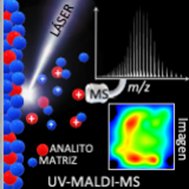Fotoquímica orgánica y espectrometría de masa UV-MALDI
-ERRA BALSELLS, Rosa. Prof Titular Consulto. DQO, FCEN, UBA. Investigador Superior CIHIDECAR-CONICET.
-SALUM, María Laura. JTP (DE), DQO, FCEN, UBA. Investigador Adjunto CIHIDECAR-CONICET.
-PETROSELLI, Gabriela. JTP (DS), DQI,AyQF, FCEN, UBA. Investigador Adjunto CIHIDECAR-CONICET.
-SCHMIDT DE LEON, Tobías. JTP (DE), DQO, FCEN, UBA. Doctorando investigador CIHIDECAR-CONICET.
-SILVA RODRIGUEZ, Oscar Enrique. Ayte 1° (DS), UNGS. Becario CONICET. Doctorando investigador CIHIDECAR-CONICET.
Resumen
La Espectrometria de Masa (MS), incluye un método de volatilización/ionización muy suave denominado UV-MALDI (Ultraviolet Matrix Assisted Laser Desorption/Ionization) que requiere una matriz (fotosensibilizador) para su iniciación. Es ésta una de las aplicaciones analíticas más exitosa y reciente de la fotoquímica. Su introducción revolucionó la analítica de los compuestos no volátiles en general (termolábiles, macromoléculas y polímeros sintéticos, biopolímeros, biomoléculas, etc.). Como parte de un proyecto cuyo objetivo es encontrar las condiciones que debe reunir (i) una especie química para actuar como matriz UV-MALDI y (ii) el par analito-matriz para optimizar la eficiencia del proceso UV-MALDI, se estudian compuestos de la familia de los hidroxi-arilcarbonílicos, hidroxi-estirilcarbonilicos, heterocíclicos nitrogenados, aromáticos naftalénicos y antracénicos ácidos y básicos, todos ellos conteniendo unidades cromofóricas fotoquímicamente activas en el rango de λ= 300-380 nm. Se estudia su estabilidad térmica, su comportamiento fotoquímico y fotofísico, su carácter ácido-base, su capacidad donora/aceptora de electrones (potenciales de óxido/reducción) tanto en el estado electrónico fundamental como en los estados electrónicos excitados.
Dado que dos de las limitaciones más serias que tiene la UV-MALDI-MS tanto para la obtención de información en forma cualitativa como cuantitativa es la inhomogeneidad de las muestras sólidas analito-matriz y la presencia de clusters a valores de m/z bajos, se diseñan y estudian líquidos iónicos (sales por combinación de cationes y/o iones orgánicos) y nanomateriales incluyendo en su estructura a los compuestos antes mencionados. Se estudia experimentalmente la potencial utilidad de todos los materiales como matrices en UV-MALDI-MS, usando como analitos macromoléculas y termolábiles (hidratos de carbono, lípidos, péptidos, glicoconjugados, polímeros sintéticos, etc.) tanto comerciales como de reciente síntesis o aislamiento de medios biológicos, provistos por investigadores mediante cooperaciones.
Abstract
Mass spectrometry (MS) includes a quite soft volatilization/ionization method called UV-MALDI (Ultraviolet Matrix Assisted Laser Desorption/Ionization) where a matrix (photosensitizer) is necessary for starting the process. It is one of the most outstanding new analytical application of the photochemistry. Thermal unstable non-volatile compounds (macromolecules and synthetic polymers, biopolymers, biomolecules, etc.) can be subjected now to MS analysis. To reach as project goal the comprehension of (i) chromophoric molecules to work as matrix and (ii) conditions for analyte-matrix system in which desorption / ionization is highly efficient in UV-MALDI, hydroxy-arylcarbonylic, hydroxy-stirylcabonylic, nitrogen heterocyclic, naphtalenic, anthracenic acid and basic compounds containing active photochemical chromophore unity in the λ= 300-380 nm range. The thermal stability, photostability (photophysics and photochemistry), acid-basic properties, the donor-acceptor electron capability (oxidation/reduction potential), in both the ground and electronic excited states will be studied. Owing to the inhomogeneous character of the solid analyte-matrix sample and the clusters signals at low m/z range, this MS technique shows serious limitation for qualitative and quantitative analytical application. Thus, new ion liquids (salts containing organic cation and/or anion species) and nanomaterials including the above mentioned structure are prepared and studied. Experimentally is checked the behavior of all the compounds as potential UV-MALDI matrices for macromolecules and thermos-unstable compounds (carbohydrates, lipids, peptides, glycoconjugates, synthetic macromolecules and polymers, etc.) both commercially available and new species recently synthesized and others extracted from bio-systems both got through scientific cooperation.
Publicaciones seleccionadas/ Selected publications
1- Photoisomerization of Ionic Liquids Ammonium Cinnamates: One-Pot Synthesis-Isolation of Z-Cinnamic Acids. M. L. Salum, C. J. Robles, R. Erra-Balsells, Org. Lett., 12, 4808-4811 (2010).
2- Photoacoustic and luminescence characterization of nitrogen heterocyclic aromatic UV-MALDI matrices in solution. G. Petroselli, P. D, Gara, G. M. Bilmes, R. Erra-Balsells, Photochem. Photobiol. Sci., 11, 1062-1068 (2012).
3- Photochemical and Thermal Stability of some Dihydroxyacetophenones used as UV-MALDI-MS Matrices. O. I. Tarzi, L. Di Stefano, J. E. Arguello, G. Oksdath-Mansilla, R. Erra-Balsells. Photochem Photobiol., 89, 1368-1374 (2013).
4- Z-Sinapinic Acid. The Change of the Stereochemistry of Cinnamic Acids as Rational Synthesis of a New Matrix for Carbohydrate MALDI-MS analysis. M. L. Salum, L.M. Itovich, R. Erra-Balsells, J. Mass Spectrom., 48, 1150-1159 (2013).
5- MALDI-MS argininyl bufadienolide esters fingerprint from parotoid gland secretions of Rhinella arenarum: age, gender and seasonal variations. G. Petroselli, M. Raices, L.D. Jungblut, A.G. Pozzi, R. Erra-Balsells, J. Mass Spectrom., 53, 465-475 (2018).
6- MALDI- and LDI-MS saponin fingerprint of leaves and sticks components of commercial yerba mate (Ilex paraguariensis). G. Petroselli, T. L. Parapugna, M. G. Lagorio, R. Erra-Balsells, J. Mass Spectrom. 54, 195-203 (2019).
7- norHarmane containing ionic liquid matrices for low molecular weight MALDI-MS carbohydrate analysis: The perfect couple with α-cyano-4-hydroxycinnamic acid. T. Schmidt De León, M. L. Salum, R. Erra-Balsells. J Mass Spectrom., 54, 643-654 (2019).
8- Understanding the role played by protic ionic liquids (PILs) and the substituent effect for enhancing the generation of Z-cinnamic acid derivatives. R. B. Rodríguez, R. L. Zapata, M. L. Salum, R. Erra-Balsells, Photochem Photobiol Sc. 19, 819-830 (2020).
